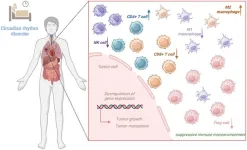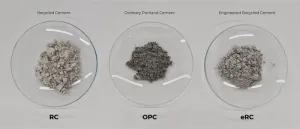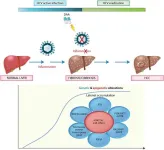Circadian rhythms are endogenous time-keeping mechanisms that regulate physiological processes in response to external light-dark cycles. These rhythms are orchestrated by the suprachiasmatic nucleus (SCN) in the hypothalamus and involve a network of genes, including CLOCK and BMAL1, that influence metabolism, immune responses, and cell proliferation. Recent research has highlighted the crucial role of circadian rhythms in tumor biology, demonstrating that their dysregulation contributes to tumorigenesis, progression, and metastasis. Additionally, circadian rhythms influence the tumor immune microenvironment and the efficacy of anticancer therapies, paving the way for potential rhythm-based precision treatments.
The Effect of Circadian Rhythms on the Biological Function of Tumors
Disruptions in circadian rhythms contribute to tumor initiation and progression through multiple mechanisms. These include metabolic reprogramming, alterations in cell cycle regulation, and changes in the immune microenvironment. The CLOCK gene, when dysregulated due to circadian disturbances such as sleep deprivation, promotes tumorigenesis by enhancing oncogenic metabolic pathways, particularly fatty acid oxidation. Additionally, the overexpression of CLOCK leads to increased inflammation and angiogenesis, supporting tumor growth.
Another key finding is the temporal heterogeneity in tumor metastasis, influenced by sleep-wake cycles. Studies have shown that circulating tumor cells (CTCs) are released predominantly during the resting phase, with significantly higher metastatic potential compared to those released during active phases. Experimental models have confirmed that sleep cycle alterations enhance CTC dissemination, underscoring the importance of time-dependent therapeutic interventions.
Circadian rhythms also modulate the tumor immune microenvironment. They regulate immune checkpoint expression, impacting immune evasion by tumor cells. The Period2 (PER2) gene, for example, reduces immune suppression by inhibiting the IKK/NF-κB pathway and downregulating PD-L1 expression. Additionally, the rhythmic oscillations of immune cells such as macrophages and T cells play a role in tumor surveillance. Circadian disruptions shift the balance between pro-inflammatory M1 macrophages and immunosuppressive M2 macrophages, fostering an environment conducive to tumor progression. This highlights the potential for circadian modulation as a strategy for improving immune-based therapies.
The Effect of Circadian Rhythms on the Efficacy of Antitumor Drug Therapy
Given their regulatory role in tumor biology, circadian rhythms also affect the pharmacokinetics and efficacy of anticancer therapies. Time-of-day-dependent variations in drug absorption, metabolism, and clearance impact the therapeutic outcomes of chemotherapy, targeted therapy, and immunotherapy.
Research on chronomodulated chemotherapy has shown that the timing of drug administration significantly influences treatment efficacy and toxicity. For instance, the tyrosine kinase inhibitor linifanib exhibits different bioavailability depending on the time of administration, with evening dosing reducing drug absorption compared to morning dosing. Similar findings have been reported for other chemotherapeutic agents, indicating that optimizing treatment schedules based on circadian rhythms could enhance efficacy while minimizing side effects.
The role of circadian rhythms in immunotherapy is also gaining attention. Studies suggest that immune checkpoint inhibitors, such as anti-PD-L1 therapy, are more effective when administered at times when suppressive immune cell activity is at its peak. Additionally, the rhythmic variations in dendritic cell activity suggest that synchronizing immunotherapies with circadian fluctuations in immune function may improve clinical outcomes.
Future Directions
Future research should focus on further elucidating the molecular mechanisms by which circadian rhythms influence tumor biology. Understanding the spatial and temporal interactions between tumor cells and the immune system will provide insights into novel therapeutic targets. Investigating rhythm-based interventions, such as the development of drugs targeting circadian genes, holds promise for enhancing cancer treatment outcomes.
Additionally, personalized cancer therapies based on an individual’s circadian rhythm profile may lead to more effective treatment regimens. Given that circadian rhythms are influenced by lifestyle and occupational factors, tailoring treatment schedules to an individual’s daily routine could optimize therapeutic benefits while minimizing adverse effects. Future studies should explore the role of lifestyle modifications, such as light exposure and sleep regulation, in mitigating cancer risk and improving patient responses to treatment.
Conclusions
Circadian rhythms play a fundamental role in regulating tumor progression, the immune microenvironment, and the efficacy of anticancer therapies. Disruptions in these rhythms contribute to tumorigenesis by altering metabolic pathways, immune responses, and cell cycle dynamics. Emerging evidence supports the use of rhythm-based therapeutic strategies, including chronomodulated chemotherapy and circadian-targeted immunotherapy, to optimize treatment efficacy. While significant progress has been made, further research is needed to translate these findings into clinical practice and develop personalized therapeutic approaches based on circadian biology. By integrating circadian rhythm insights into oncology, the field of precision medicine may unlock new avenues for cancer prevention and treatment.
Full text:
https://www.xiahepublishing.com/2472-0712/ERHM-2024-00038
The study was recently published in the Exploratory Research and Hypothesis in Medicine.
Exploratory Research and Hypothesis in Medicine (ERHM) publishes original exploratory research articles and state-of-the-art reviews that focus on novel findings and the most recent scientific advances that support new hypotheses in medicine. The journal accepts a wide range of topics, including innovative diagnostic and therapeutic modalities as well as insightful theories related to the practice of medicine. The exploratory research published in ERHM does not necessarily need to be comprehensive and conclusive, but the study design must be solid, the methodologies must be reliable, the results must be true, and the hypothesis must be rational and justifiable with evidence.
Follow us on X: @xiahepublishing
Follow us on LinkedIn: Xia & He Publishing Inc.
END







